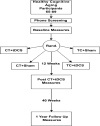Augmenting cognitive training in older adults (The ACT Study): Design and Methods of a Phase III tDCS and cognitive training trial
- PMID: 29313802
- PMCID: PMC5803439
- DOI: 10.1016/j.cct.2017.11.017
Augmenting cognitive training in older adults (The ACT Study): Design and Methods of a Phase III tDCS and cognitive training trial
Abstract
Background: Adults over age 65 represent the fastest growing population in the US. Decline in cognitive abilities is a hallmark of advanced age and is associated with loss of independence and dementia risk. There is a pressing need to develop effective interventions for slowing or reversing the cognitive aging process. While certain forms of cognitive training have shown promise in this area, effects only sometimes transfer to neuropsychological tests within or outside the trained domain. This paper describes a NIA-funded Phase III adaptive multisite randomized clinical trial, examining whether transcranial direct current stimulation (tDCS) of frontal cortices enhances neurocognitive outcomes achieved from cognitive training in older adults experiencing age-related cognitive decline: the Augmenting Cognitive Training in Older Adults study (ACT).
Methods: ACT will enroll 360 participants aged 65 to 89 with age-related cognitive decline, but not dementia. Participants will undergo cognitive training intervention or education training-control combined with tDCS or sham tDCS control. Cognitive training employs a suite of eight adaptive training tasks focused on attention/speed of processing and working memory from Posit Science BrainHQ. Training control involves exposure to educational nature/history videos and related content questions of the same interval/duration as the cognitive training. Participants are assessed at baseline, after training (12weeks), and 12-month follow-up on our primary outcome measure, NIH Toolbox Fluid Cognition Composite Score, as well as a comprehensive neurocognitive, functional, clinical and multimodal neuroimaging battery.
Significance: The findings from this study have the potential to significantly enhance efforts to ameliorate cognitive aging and slow dementia.
Keywords: Adaptive randomized clinical trial design; Aging; Cognitive training; Phase III; Transcranial direct current stimulation; tDCS.
Copyright © 2017 Elsevier Inc. All rights reserved.
Figures






Similar articles
-
Facilitation of working memory capacity by transcranial direct current stimulation: a secondary analysis from the augmenting cognitive training in older adults (ACT) study.Geroscience. 2024 Oct;46(5):4075-4110. doi: 10.1007/s11357-024-01205-0. Epub 2024 May 25. Geroscience. 2024. PMID: 38789832 Free PMC article. Clinical Trial.
-
Primary outcome from the augmenting cognitive training in older adults study (ACT): A tDCS and cognitive training randomized clinical trial.Brain Stimul. 2023 May-Jun;16(3):904-917. doi: 10.1016/j.brs.2023.05.021. Epub 2023 May 26. Brain Stimul. 2023. PMID: 37245842 Free PMC article. Clinical Trial.
-
Would transcranial direct current stimulation (tDCS) enhance the effects of working memory training in older adults with mild neurocognitive disorder due to Alzheimer's disease: study protocol for a randomized controlled trial.Trials. 2015 Oct 24;16:479. doi: 10.1186/s13063-015-0999-0. Trials. 2015. PMID: 26499250 Free PMC article. Clinical Trial.
-
Computerised cognitive training for 12 or more weeks for maintaining cognitive function in cognitively healthy people in late life.Cochrane Database Syst Rev. 2020 Feb 27;2(2):CD012277. doi: 10.1002/14651858.CD012277.pub3. Cochrane Database Syst Rev. 2020. PMID: 32104914 Free PMC article.
-
Effects of Transcranial Direct Current Stimulation on Cognitive Function in Older Adults with and without Mild Cognitive Impairment: A Systematic Review and Meta-Analysis of Randomized Controlled Trials.Gerontology. 2024;70(5):544-560. doi: 10.1159/000537848. Epub 2024 Mar 8. Gerontology. 2024. PMID: 38452749
Cited by
-
Task-based functional connectivity of the Useful Field of View (UFOV) fMRI task.Geroscience. 2023 Feb;45(1):293-309. doi: 10.1007/s11357-022-00632-1. Epub 2022 Aug 11. Geroscience. 2023. PMID: 35948860 Free PMC article.
-
Higher-order resting state network association with the useful field of view task in older adults.Geroscience. 2022 Feb;44(1):131-145. doi: 10.1007/s11357-021-00441-y. Epub 2021 Aug 25. Geroscience. 2022. PMID: 34431043 Free PMC article.
-
The Role of Resting-State Network Functional Connectivity in Cognitive Aging.Front Aging Neurosci. 2020 Jun 12;12:177. doi: 10.3389/fnagi.2020.00177. eCollection 2020. Front Aging Neurosci. 2020. PMID: 32595490 Free PMC article.
-
The longitudinal impact of the COVID-19 pandemic on health behaviors, psychosocial factors, and cognitive functioning in older adults.Front Aging Neurosci. 2022 Nov 25;14:999107. doi: 10.3389/fnagi.2022.999107. eCollection 2022. Front Aging Neurosci. 2022. PMID: 36506467 Free PMC article.
-
Cingulo-opercular and frontoparietal control network connectivity and executive functioning in older adults.Geroscience. 2022 Apr;44(2):847-866. doi: 10.1007/s11357-021-00503-1. Epub 2021 Dec 23. Geroscience. 2022. PMID: 34950997 Free PMC article.
References
Publication types
MeSH terms
Grants and funding
LinkOut - more resources
Full Text Sources
Other Literature Sources
Medical

